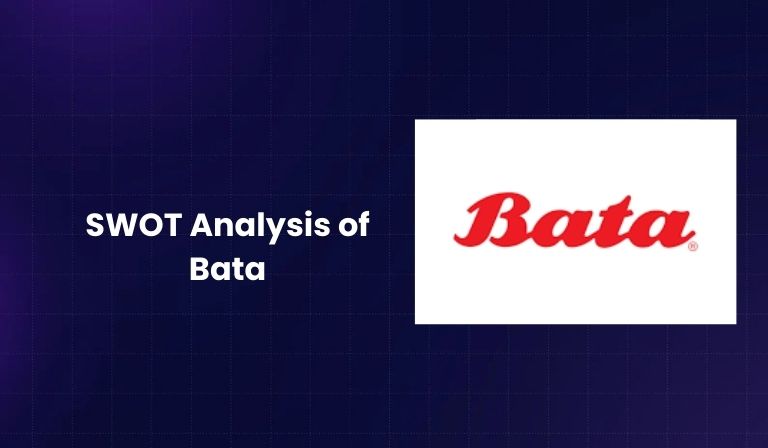Bata is a global footwear and fashion accessory brand that has been around for over a century. Founded in 1894 by Tomas Bata in Zlin, Czech Republic, the company has established itself as a leading player in the global footwear market. With its rich history, Bata has expanded its reach to over 70 countries, with India being one of its key markets.
Despite facing numerous challenges in a competitive industry, Bata continues to remain relevant by adapting to changing trends and consumer demands. In this blog, we’ll conduct a comprehensive SWOT (Strengths, Weaknesses, Opportunities, and Threats) analysis of Bata, to better understand the company’s position and future prospects.
Strengths in Bata’s SWOT Analysis
Global Presence
Bata’s widespread global presence is one of its biggest strengths. With operations in over 70 countries and production facilities in 27 countries, Bata is well-positioned to cater to diverse markets. This global reach enables Bata to reduce dependency on any single market, providing a buffer against regional economic fluctuations. The company’s robust distribution network ensures its presence in both emerging and developed economies, making it a truly international brand.
Market Penetration
Bata has made significant inroads into various markets, especially in India, where it has a commanding presence in over 500 cities. The brand is present in both metropolitan cities and small towns, giving it a broad customer base. This wide market penetration not only helps Bata maintain a loyal customer base but also allows it to capture new demand as cities and towns continue to grow.
Strong Distribution Network
Bata’s distribution network is one of the strongest in the footwear industry. With more than 5000 retail stores worldwide, and over 1200 stores in India alone, Bata has ensured that its products are easily accessible to a wide range of consumers. Its strategic retail locations and partnerships with e-commerce platforms have solidified its market presence, making Bata shoes readily available to millions.
Excellent Positioning
Bata has effectively positioned itself as a brand that offers fashionable yet affordable footwear. It successfully balances style and cost, catering to a wide demographic of consumers. The brand is synonymous with comfort, quality, and affordability, which has helped it stay relevant for more than a century. Bata’s pricing strategy ensures that it remains accessible while still maintaining an image of quality and style.
Cost Advantage
Another key strength of Bata is its cost advantage. By manufacturing a vast range of footwear at affordable prices, the company has been able to attract a broad customer base. Bata’s ability to offer quality footwear at competitive prices sets it apart from many of its competitors and gives it an edge in the highly competitive footwear industry.
Weaknesses in Bata’s SWOT Analysis
Limited Market Share Due to Competition
While Bata has a strong market presence, it has been facing intense competition from both international brands and local players. This heightened competition has led to a reduction in Bata’s market share, which currently stands at only 6%. Bata’s inability to significantly increase its market share in the face of growing competition presents a major challenge, especially as consumer preferences continue to shift towards more premium and niche brands.
Falling Sales
Despite growing profits in recent years, Bata India’s sales have been experiencing a consistent downward trend. This paradox of rising profits amid falling sales suggests that while Bata may have improved its profit margins, it is struggling to attract as many customers as it once did. This decline in sales may be indicative of changing consumer preferences, with customers opting for more trendy or premium alternatives.
Low Quality Image
Due to its affordable pricing, Bata has developed a perception problem among some consumers. Many people associate lower prices with lower quality, and this pricing strategy has led to a perception of Bata shoes as inferior. While this may not be entirely accurate, the brand’s focus on affordability has hindered its ability to break into the premium footwear segment, where perceptions of higher quality and exclusivity are key factors.
Opportunities in Bata’s SWOT Analysis
Footwear as a Fashion Statement
Footwear is no longer just a necessity; it has become a fashion statement for many consumers. As style-conscious consumers demand more trendy and fashionable shoes, Bata has the opportunity to capitalize on this growing trend. By introducing new collections that cater to the latest fashion trends, Bata can expand its market reach and attract younger customers who are looking for stylish yet affordable footwear options.
Growing Rural Market
Bata has a strong foothold in India, but there is significant growth potential in the rural markets. With increasing urbanization and rising disposable incomes in rural areas, the demand for quality footwear is growing rapidly. Bata has the opportunity to tap into this burgeoning market by introducing affordable yet fashionable footwear designed for rural consumers, who are becoming more brand-conscious and fashion-forward.
Growing Demand in the Premium Footwear Category
As emerging economies, particularly in Asia, experience a rise in living standards, the demand for premium products, including footwear, is also increasing. Bata can seize this opportunity by expanding its offerings in the premium footwear category. Introducing higher-end products that appeal to affluent consumers in emerging markets will allow Bata to diversify its product portfolio and cater to an untapped segment of the market.
Threats in Bata’s SWOT Analysis
Intense Competition
Bata faces fierce competition from both international and local footwear brands. Companies like Nike, Adidas, and Puma have a stronghold in the premium footwear segment, while local brands are capturing market share by offering affordable alternatives. This competition makes it difficult for Bata to expand its customer base and grow its market share. In order to remain competitive, Bata needs to continuously innovate and find ways to differentiate itself from its competitors.
Duplicity in the Market
The footwear industry is also plagued by counterfeit products, which poses a significant threat to Bata’s sales and brand reputation. Knockoff versions of Bata shoes are widely available in markets, especially in emerging economies, and these counterfeit products not only harm sales but also weaken the brand’s credibility. Bata will need to strengthen its brand protection strategies and educate consumers about the dangers of purchasing counterfeit products.
Conclusion
Bata’s global presence, strong distribution network, and cost advantage are key strengths that have helped it maintain its position as a leading footwear brand for over a century. However, the company faces several challenges, including intense competition, falling sales, and a perception of low quality. To capitalize on growth opportunities, Bata must tap into the rising demand for fashionable footwear, expand its presence in rural markets, and diversify into the premium footwear segment. By addressing these challenges and seizing new opportunities, Bata can continue to strengthen its brand and remain a dominant player in the footwear industry.
FAQs
1. What are Bata’s key strengths?
Bata’s key strengths include its global presence in over 70 countries, a strong distribution network with more than 5000 retail stores, effective market penetration, excellent positioning as an affordable yet fashionable brand, and a significant cost advantage in manufacturing.
2. Why is Bata facing a decline in market share?
Bata’s market share has been shrinking due to intense competition from both international and local footwear brands. This has made it difficult for Bata to maintain its dominant position in the market.
3. What are the opportunities for Bata in emerging markets?
Bata can capitalize on the growing demand for fashionable footwear, especially in emerging markets. Additionally, expanding into the premium footwear segment and tapping into the growing rural market present significant opportunities for growth.
4. How is Bata positioning itself in the footwear market?
Bata positions itself as a brand offering fashionable and affordable footwear. This positioning allows it to cater to a wide range of consumers, from budget-conscious buyers to style-conscious individuals looking for trendy options.
5. What challenges does Bata face in terms of brand perception?
Bata faces a perception challenge, as many consumers associate its affordable pricing with lower quality. Overcoming this perception and positioning itself as a provider of high-quality yet affordable footwear is crucial for Bata’s future success.
A digital marketer with a strong focus on SEO, content creation, and AI tools. Creates helpful, easy-to-understand content that connects with readers and ranks well on search engines. Loves using smart tools to save time, improve content quality, and grow online reach.

